Feng Zhao
Group Critical-token Policy Optimization for Autoregressive Image Generation
Sep 26, 2025Abstract:Recent studies have extended Reinforcement Learning with Verifiable Rewards (RLVR) to autoregressive (AR) visual generation and achieved promising progress. However, existing methods typically apply uniform optimization across all image tokens, while the varying contributions of different image tokens for RLVR's training remain unexplored. In fact, the key obstacle lies in how to identify more critical image tokens during AR generation and implement effective token-wise optimization for them. To tackle this challenge, we propose $\textbf{G}$roup $\textbf{C}$ritical-token $\textbf{P}$olicy $\textbf{O}$ptimization ($\textbf{GCPO}$), which facilitates effective policy optimization on critical tokens. We identify the critical tokens in RLVR-based AR generation from three perspectives, specifically: $\textbf{(1)}$ Causal dependency: early tokens fundamentally determine the later tokens and final image effect due to unidirectional dependency; $\textbf{(2)}$ Entropy-induced spatial structure: tokens with high entropy gradients correspond to image structure and bridges distinct visual regions; $\textbf{(3)}$ RLVR-focused token diversity: tokens with low visual similarity across a group of sampled images contribute to richer token-level diversity. For these identified critical tokens, we further introduce a dynamic token-wise advantage weight to encourage exploration, based on confidence divergence between the policy model and reference model. By leveraging 30\% of the image tokens, GCPO achieves better performance than GRPO with full tokens. Extensive experiments on multiple text-to-image benchmarks for both AR models and unified multimodal models demonstrate the effectiveness of GCPO for AR visual generation.
Gaussian Variation Field Diffusion for High-fidelity Video-to-4D Synthesis
Jul 31, 2025Abstract:In this paper, we present a novel framework for video-to-4D generation that creates high-quality dynamic 3D content from single video inputs. Direct 4D diffusion modeling is extremely challenging due to costly data construction and the high-dimensional nature of jointly representing 3D shape, appearance, and motion. We address these challenges by introducing a Direct 4DMesh-to-GS Variation Field VAE that directly encodes canonical Gaussian Splats (GS) and their temporal variations from 3D animation data without per-instance fitting, and compresses high-dimensional animations into a compact latent space. Building upon this efficient representation, we train a Gaussian Variation Field diffusion model with temporal-aware Diffusion Transformer conditioned on input videos and canonical GS. Trained on carefully-curated animatable 3D objects from the Objaverse dataset, our model demonstrates superior generation quality compared to existing methods. It also exhibits remarkable generalization to in-the-wild video inputs despite being trained exclusively on synthetic data, paving the way for generating high-quality animated 3D content. Project page: https://gvfdiffusion.github.io/.
InstructVLA: Vision-Language-Action Instruction Tuning from Understanding to Manipulation
Jul 23, 2025Abstract:To operate effectively in the real world, robots must integrate multimodal reasoning with precise action generation. However, existing vision-language-action (VLA) models often sacrifice one for the other, narrow their abilities to task-specific manipulation data, and suffer catastrophic forgetting of pre-trained vision-language capabilities. To bridge this gap, we introduce InstructVLA, an end-to-end VLA model that preserves the flexible reasoning of large vision-language models (VLMs) while delivering leading manipulation performance. InstructVLA introduces a novel training paradigm, Vision-Language-Action Instruction Tuning (VLA-IT), which employs multimodal training with mixture-of-experts adaptation to jointly optimize textual reasoning and action generation on both standard VLM corpora and a curated 650K-sample VLA-IT dataset. On in-domain SimplerEnv tasks, InstructVLA achieves 30.5% improvement over SpatialVLA. To evaluate generalization, we introduce SimplerEnv-Instruct, an 80-task benchmark requiring closed-loop control and high-level instruction understanding, where it outperforms a fine-tuned OpenVLA by 92% and an action expert aided by GPT-4o by 29%. Additionally, InstructVLA surpasses baseline VLMs on multimodal tasks and exhibits inference-time scaling by leveraging textual reasoning to boost manipulation performance in both simulated and real-world settings. These results demonstrate InstructVLA's potential for bridging intuitive and steerable human-robot interaction with efficient policy learning.
CronusVLA: Transferring Latent Motion Across Time for Multi-Frame Prediction in Manipulation
Jun 24, 2025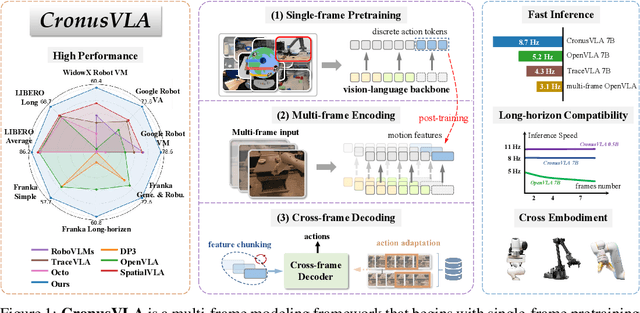
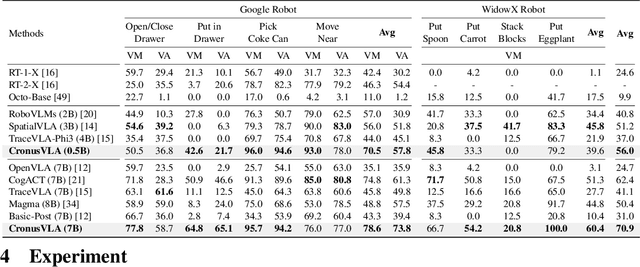
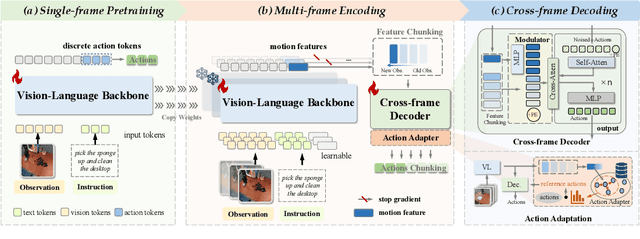
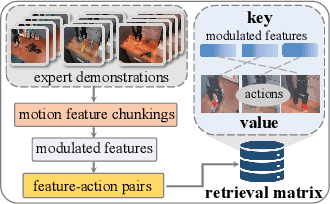
Abstract:Recent vision-language-action (VLA) models built on pretrained vision-language models (VLMs) have demonstrated strong generalization across manipulation tasks. However, they remain constrained by a single-frame observation paradigm and cannot fully benefit from the motion information offered by aggregated multi-frame historical observations, as the large vision-language backbone introduces substantial computational cost and inference latency. We propose CronusVLA, a unified framework that extends single-frame VLA models to the multi-frame paradigm through an efficient post-training stage. CronusVLA comprises three key components: (1) single-frame pretraining on large-scale embodied datasets with autoregressive action tokens prediction, which establishes an embodied vision-language foundation; (2) multi-frame encoding, adapting the prediction of vision-language backbones from discrete action tokens to motion features during post-training, and aggregating motion features from historical frames into a feature chunking; (3) cross-frame decoding, which maps the feature chunking to accurate actions via a shared decoder with cross-attention. By reducing redundant token computation and caching past motion features, CronusVLA achieves efficient inference. As an application of motion features, we further propose an action adaptation mechanism based on feature-action retrieval to improve model performance during finetuning. CronusVLA achieves state-of-the-art performance on SimplerEnv with 70.9% success rate, and 12.7% improvement over OpenVLA on LIBERO. Real-world Franka experiments also show the strong performance and robustness.
VideoMAR: Autoregressive Video Generatio with Continuous Tokens
Jun 18, 2025Abstract:Masked-based autoregressive models have demonstrated promising image generation capability in continuous space. However, their potential for video generation remains under-explored. In this paper, we propose \textbf{VideoMAR}, a concise and efficient decoder-only autoregressive image-to-video model with continuous tokens, composing temporal frame-by-frame and spatial masked generation. We first identify temporal causality and spatial bi-directionality as the first principle of video AR models, and propose the next-frame diffusion loss for the integration of mask and video generation. Besides, the huge cost and difficulty of long sequence autoregressive modeling is a basic but crucial issue. To this end, we propose the temporal short-to-long curriculum learning and spatial progressive resolution training, and employ progressive temperature strategy at inference time to mitigate the accumulation error. Furthermore, VideoMAR replicates several unique capacities of language models to video generation. It inherently bears high efficiency due to simultaneous temporal-wise KV cache and spatial-wise parallel generation, and presents the capacity of spatial and temporal extrapolation via 3D rotary embeddings. On the VBench-I2V benchmark, VideoMAR surpasses the previous state-of-the-art (Cosmos I2V) while requiring significantly fewer parameters ($9.3\%$), training data ($0.5\%$), and GPU resources ($0.2\%$).
DualFast: Dual-Speedup Framework for Fast Sampling of Diffusion Models
Jun 16, 2025Abstract:Diffusion probabilistic models (DPMs) have achieved impressive success in visual generation. While, they suffer from slow inference speed due to iterative sampling. Employing fewer sampling steps is an intuitive solution, but this will also introduces discretization error. Existing fast samplers make inspiring efforts to reduce discretization error through the adoption of high-order solvers, potentially reaching a plateau in terms of optimization. This raises the question: can the sampling process be accelerated further? In this paper, we re-examine the nature of sampling errors, discerning that they comprise two distinct elements: the widely recognized discretization error and the less explored approximation error. Our research elucidates the dynamics between these errors and the step by implementing a dual-error disentanglement strategy. Building on these foundations, we introduce an unified and training-free acceleration framework, DualFast, designed to enhance the speed of DPM sampling by concurrently accounting for both error types, thereby minimizing the total sampling error. DualFast is seamlessly compatible with existing samplers and significantly boost their sampling quality and speed, particularly in extremely few sampling steps. We substantiate the effectiveness of our framework through comprehensive experiments, spanning both unconditional and conditional sampling domains, across both pixel-space and latent-space DPMs.
Adaptive Dropout: Unleashing Dropout across Layers for Generalizable Image Super-Resolution
Jun 15, 2025Abstract:Blind Super-Resolution (blind SR) aims to enhance the model's generalization ability with unknown degradation, yet it still encounters severe overfitting issues. Some previous methods inspired by dropout, which enhances generalization by regularizing features, have shown promising results in blind SR. Nevertheless, these methods focus solely on regularizing features before the final layer and overlook the need for generalization in features at intermediate layers. Without explicit regularization of features at intermediate layers, the blind SR network struggles to obtain well-generalized feature representations. However, the key challenge is that directly applying dropout to intermediate layers leads to a significant performance drop, which we attribute to the inconsistency in training-testing and across layers it introduced. Therefore, we propose Adaptive Dropout, a new regularization method for blind SR models, which mitigates the inconsistency and facilitates application across intermediate layers of networks. Specifically, for training-testing inconsistency, we re-design the form of dropout and integrate the features before and after dropout adaptively. For inconsistency in generalization requirements across different layers, we innovatively design an adaptive training strategy to strengthen feature propagation by layer-wise annealing. Experimental results show that our method outperforms all past regularization methods on both synthetic and real-world benchmark datasets, also highly effective in other image restoration tasks. Code is available at \href{https://github.com/xuhang07/Adpative-Dropout}{https://github.com/xuhang07/Adpative-Dropout}.
AnySplat: Feed-forward 3D Gaussian Splatting from Unconstrained Views
May 29, 2025Abstract:We introduce AnySplat, a feed forward network for novel view synthesis from uncalibrated image collections. In contrast to traditional neural rendering pipelines that demand known camera poses and per scene optimization, or recent feed forward methods that buckle under the computational weight of dense views, our model predicts everything in one shot. A single forward pass yields a set of 3D Gaussian primitives encoding both scene geometry and appearance, and the corresponding camera intrinsics and extrinsics for each input image. This unified design scales effortlessly to casually captured, multi view datasets without any pose annotations. In extensive zero shot evaluations, AnySplat matches the quality of pose aware baselines in both sparse and dense view scenarios while surpassing existing pose free approaches. Moreover, it greatly reduce rendering latency compared to optimization based neural fields, bringing real time novel view synthesis within reach for unconstrained capture settings.Project page: https://city-super.github.io/anysplat/
VRAG-RL: Empower Vision-Perception-Based RAG for Visually Rich Information Understanding via Iterative Reasoning with Reinforcement Learning
May 28, 2025Abstract:Effectively retrieving, reasoning and understanding visually rich information remains a challenge for RAG methods. Traditional text-based methods cannot handle visual-related information. On the other hand, current vision-based RAG approaches are often limited by fixed pipelines and frequently struggle to reason effectively due to the insufficient activation of the fundamental capabilities of models. As RL has been proven to be beneficial for model reasoning, we introduce VRAG-RL, a novel RL framework tailored for complex reasoning across visually rich information. With this framework, VLMs interact with search engines, autonomously sampling single-turn or multi-turn reasoning trajectories with the help of visual perception tokens and undergoing continual optimization based on these samples. Our approach highlights key limitations of RL in RAG domains: (i) Prior Multi-modal RAG approaches tend to merely incorporate images into the context, leading to insufficient reasoning token allocation and neglecting visual-specific perception; and (ii) When models interact with search engines, their queries often fail to retrieve relevant information due to the inability to articulate requirements, thereby leading to suboptimal performance. To address these challenges, we define an action space tailored for visually rich inputs, with actions including cropping and scaling, allowing the model to gather information from a coarse-to-fine perspective. Furthermore, to bridge the gap between users' original inquiries and the retriever, we employ a simple yet effective reward that integrates query rewriting and retrieval performance with a model-based reward. Our VRAG-RL optimizes VLMs for RAG tasks using specially designed RL strategies, aligning the model with real-world applications. The code is available at \hyperlink{https://github.com/Alibaba-NLP/VRAG}{https://github.com/Alibaba-NLP/VRAG}.
FreePCA: Integrating Consistency Information across Long-short Frames in Training-free Long Video Generation via Principal Component Analysis
May 02, 2025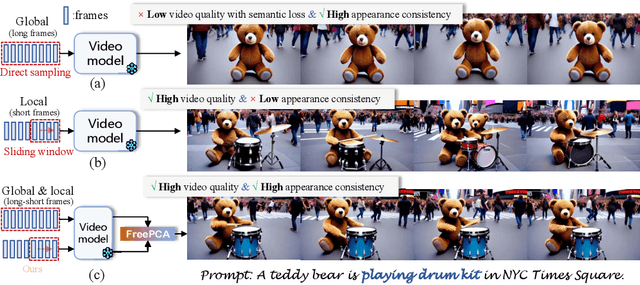
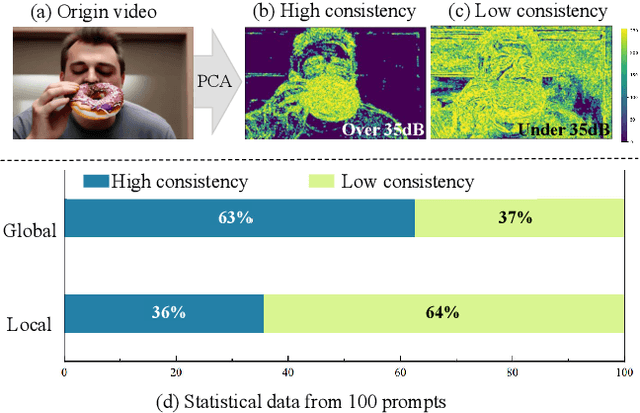
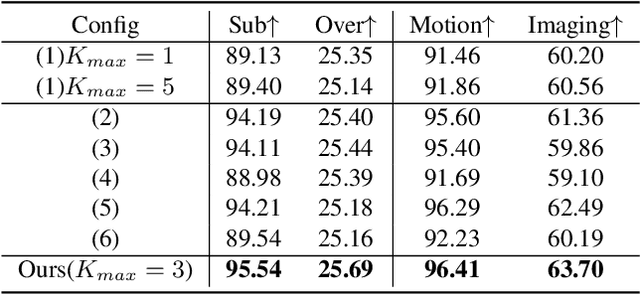
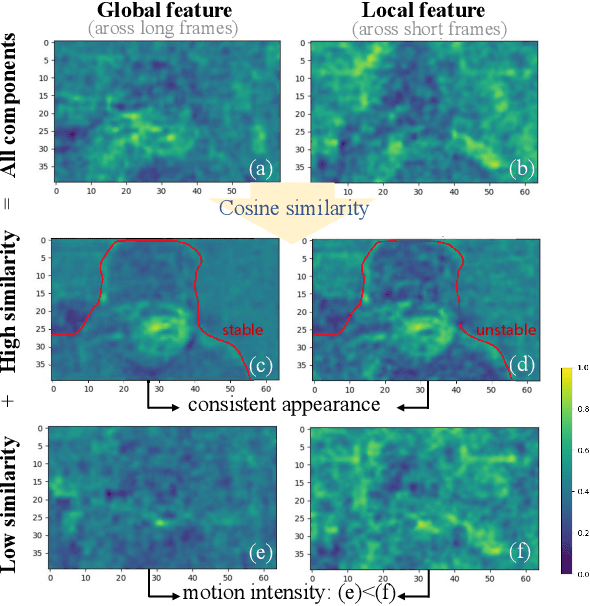
Abstract:Long video generation involves generating extended videos using models trained on short videos, suffering from distribution shifts due to varying frame counts. It necessitates the use of local information from the original short frames to enhance visual and motion quality, and global information from the entire long frames to ensure appearance consistency. Existing training-free methods struggle to effectively integrate the benefits of both, as appearance and motion in videos are closely coupled, leading to motion inconsistency and visual quality. In this paper, we reveal that global and local information can be precisely decoupled into consistent appearance and motion intensity information by applying Principal Component Analysis (PCA), allowing for refined complementary integration of global consistency and local quality. With this insight, we propose FreePCA, a training-free long video generation paradigm based on PCA that simultaneously achieves high consistency and quality. Concretely, we decouple consistent appearance and motion intensity features by measuring cosine similarity in the principal component space. Critically, we progressively integrate these features to preserve original quality and ensure smooth transitions, while further enhancing consistency by reusing the mean statistics of the initial noise. Experiments demonstrate that FreePCA can be applied to various video diffusion models without requiring training, leading to substantial improvements. Code is available at https://github.com/JosephTiTan/FreePCA.
 Add to Chrome
Add to Chrome Add to Firefox
Add to Firefox Add to Edge
Add to Edge